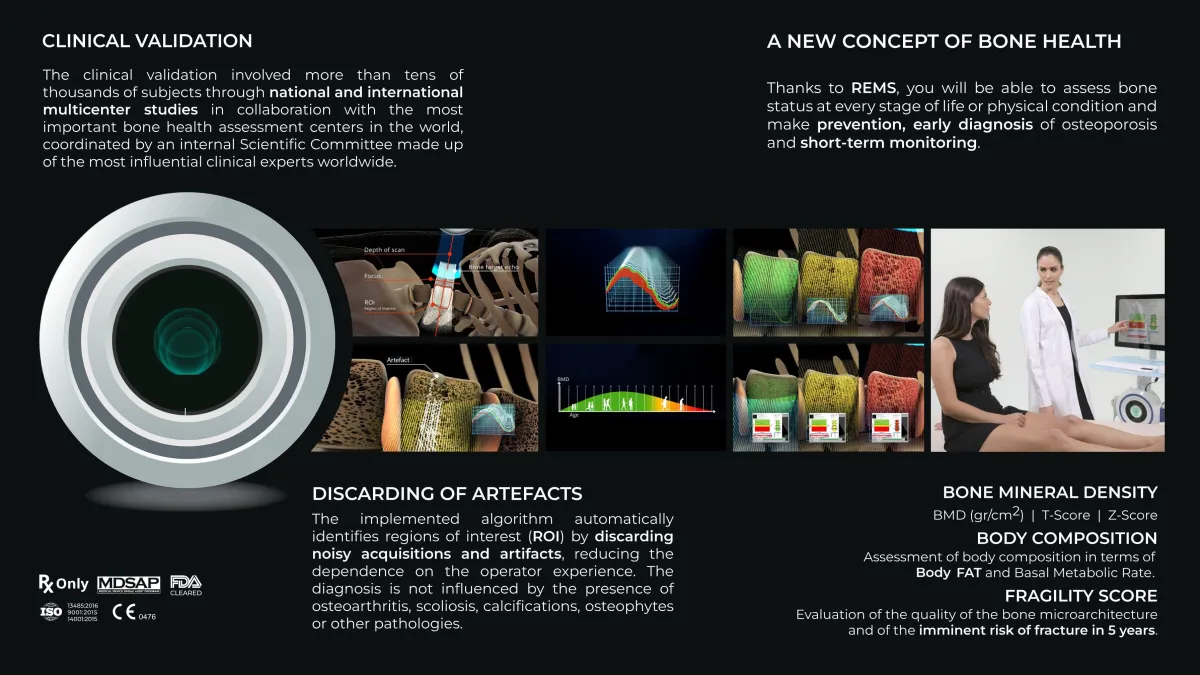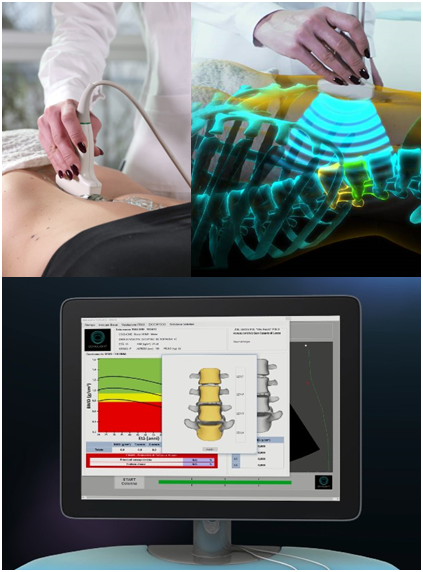
DEXA vs REMS: Understanding Bone Density Scans
Guide to Understanding How DEXA and REMS Scans Work for Bone Density
Did you know that 1 in 3 women over 50 will suffer an osteoporosis-related fracture? Millions more have low bone density and don't even know it until an injury happens. Your bones are not just the structure that carries your body; they are also the foundation of your strength, balance, and independence.
If you're over 40, recovering from bone issues, or just want to stay stronger longer, understanding your bone density could be one of the smartest health choices you make.
For years, Dual Energy X-ray Absorptiometry (DEXA) has been the standard for assessing bone health. Now, newer options like Radiofrequency Echographic Multi-Spectrometry (REMS) provide a radiation-free alternative for bone scans. Both are crucial in osteoporosis screening and early detection of bone loss.
Here, you'll learn the basics of DEXA and REMS bone density scans, what makes them different, and how to choose the best one for your needs. We'll explore how each technology works, its pros and cons, and critical factors like safety, cost, and accuracy that influence your decision.

Table of Contents:
Understanding DEXA Technology
Understanding REMS Technology
DEXA vs REMS: Which Bone Density Scan Is Right for You?
Preparation and Results Interpretation: What to Know
Making Your Decision: Key Factors to Consider
FAQs About Bone Density Testing
Wrapping Up
Understanding DEXA Technology
Dual Energy X-ray Absorptiometry (DEXA) is the most common method for measuring bone mineral density. It uses two low-dose X-ray beams to scan specific areas prone to osteoporosis-related fractures, such as the spine, hip, and sometimes the forearm. The procedure is quick, painless, and non-invasive, typically taking about 10–20 minutes while you lie still on a padded table.
Advantages:
Highly validated and widely trusted worldwide
Usually covered by insurance for at-risk populations
Provides a comprehensive snapshot of overall bone density and fracture risk
Limitations:
Involves low-dose ionizing radiation
Requires large, specialized equipment that is not always available in every clinic
May not be suitable for certain individuals (e.g., pregnancy, severe obesity)
DEXA offers great utility for initial osteoporosis screening methods and ongoing monitoring but is limited compared to newer technologies.
Understanding REMS Technology
Radiofrequency Echographic Multi-Spectrometry (REMS) is an innovative, ultrasound-based method for measuring bone mineral density without radiation exposure. Unlike X-ray scans, REMS uses radiofrequency signals gathered from bone tissue to assess density and compare results to reference models.
During a REMS exam, a handheld probe is placed at key sites such as the lumbar spine or femoral neck—the same areas often examined with DEXA. The scan is quick, painless, and can be performed while lying down or sitting. Results, including a T-score, are generated in real time and available immediately for review.
Advantages:
Ideal for radiation-sensitive individuals or those needing frequent monitoring
Can be used outside hospitals and traditional imaging centers
Results are delivered in real-time
Comprehensive overview and pictures displaying bone health
Supports ongoing bone health assessment
Limitations:
Newer technology with less long-term data compared to DEXA
Limited insurance coverage in some regions
REMS is ideal for patients who require regular monitoring, those seeking to avoid radiation exposure, and mobile screening programs. It's seen as a superior alternative to DEXA. With REMS, patients can get a radiation-free bone scan, making ongoing osteoporosis screening more convenient and user-friendly.
DEXA vs REMS: Which Bone Density Scan Is Right for You?
When comparing DEXA vs REMS bone density scans, both technologies help detect osteoporosis and predict fracture risk, but they differ in accuracy, safety, and practicality.
Accuracy & Safety
DEXA has decades of clinical validation and remains the benchmark for osteoporosis diagnosis. It uses low-dose X-rays (~0.001 mSv per scan), which is minimal but still involves radiation.
REMS, by contrast, uses ultrasound signals and has zero radiation exposure, making it safer for frequent monitoring and radiation-sensitive groups.
Both methods offer accurate bone mineral density testing. However, REMS is a newer approach that offers less risk of fractures and has been validated for its long-term effectiveness.
Practical Considerations
A DEXA scan usually takes 10–30 minutes, while REMS can provide results in about 20 minutes, making it a better option for busy people. DEXA machines are large and mostly found in hospitals or imaging centers, whereas REMS devices are portable and can be used in clinics or mobile screening units.
DEXA is widely covered by insurance for high-risk patients, while REMS coverage is more limited. Both procedures are comfortable and non-invasive, with little to no special preparation required.
When to Choose Each Technology
Choose DEXA if it's your first bone density test, your doctor requires an insurance-covered scan, or you're participating in clinical research.
Choose REMS if you need frequent monitoring, wish to avoid any radiation exposure, or want the convenience of mobile or community-based screening.
In clinical scenarios, both are valuable. DEXA is ideal for initial bone health assessments and standardized monitoring, while REMS shines for high-risk patients needing repeated scans or those with access challenges.
In short, the right choice depends on your health goals, risk factors, and practical needs—both technologies play a vital role in modern osteoporosis screening methods.
Preparation and Results Interpretation: What to Know
Proper preparation helps ensure accurate results from any bone density test comparison, whether you choose a DEXA scan or REMS technology.
Pre-Scan Preparation
For DEXA
Avoid calcium or vitamin D supplements for 24 hours before your test to prevent interference with readings.
Wear loose, metal-free clothing; zippers, belts, or jewelry may need to be removed.
If you've had a CT, MRI, or X-ray with contrast recently, let your provider know. You may need to wait 1–2 weeks.
For REMS
Preparation is minimal. Avoid eating for 3 hours before the test to prevent gas from interfering with readings. Staying well-hydrated can also help improve ultrasound signal quality.
There are no concerns regarding metal or prior imaging studies.
For both tests
Bring a list of medications—especially steroids or osteoporosis drugs—as they can influence interpretation. Expect a painless, non-invasive scan lasting only minutes, with no recovery time needed.
Understanding Your Results
Both technologies measure bone mineral density (BMD) using T-scores and Z-scores:
Normal: T-score -1.0 or above
Osteopenia: Between -1.0 and -2.5
Osteoporosis: -2.5 or below
Note: Z-scores compare your results to those of peers of the same age and sex.
REMS adds a fragility score, which provides extra insight into bone quality and fracture risk. Results can vary slightly between DEXA and REMS due to different methods. Your doctor will interpret findings alongside your medical history and risk factors to create a personalized bone health plan.

Making Your Decision: Key Factors to Consider
Choosing between a DEXA vs REMS bone density scan depends on your personal health profile and access to care.
Patient-Specific Considerations
If you're over 40, postmenopausal, or have risk factors like family history, prior fractures, or long-term steroid use, regular bone mineral density testing is crucial. For those sensitive to radiation or needing frequent scans, REMS offers a radiation-free bone scan alternative.
Mobility and location also matter—DEXA machines are usually hospital-based, while REMS devices are portable and often available in community or mobile programs. Consider how often you'll need monitoring; ongoing treatment frequently benefits from scans that can be repeated safely and conveniently.
Healthcare Provider Consultation
Talk to your doctor about which test aligns best with your situation. Ask:
How often should I be screened given my risk factors?
Does insurance cover DEXA or REMS in my area?
Should I seek a second opinion if the results are unclear?
Insurance typically covers DEXA for high-risk patients, while REMS coverage varies. Geographic access can also influence your choice. While DEXA is widespread, REMS is currently expanding.
By weighing your medical needs, safety, and convenience with professional guidance, you can make an informed bone health assessment decision that supports long-term strength and independence.
FAQs About Bone Density Testing
Which bone density test is more accurate – DEXA or REMS?
DEXA has decades of clinical validation and remains the most common osteoporosis screening method. REMS demonstrates a strong correlation with DEXA and offers reliable bone density scan accuracy despite being a newer alternative.
Is REMS safe during pregnancy, unlike DEXA?
Yes. Unlike DEXA, which uses very low-dose radiation that might be risky and should be avoided during pregnancy, REMS is a radiation-free bone scan, making it safer for expectant mothers or anyone avoiding X-rays.
How much does each test cost, and does insurance cover them?
DEXA costs typically range from $75–$300 and are widely covered by insurance for at-risk groups. REMS pricing varies by provider and region; coverage is growing but not yet universal. Always confirm with your healthcare provider and insurer.
How often should I get bone density testing with each method?
For most adults over 50 or those with risk factors, testing every 1–2 years is recommended. Because REMS has no radiation, it can be safely performed more frequently for treatment monitoring or high-risk patients.
Wrapping Up
Both DEXA and REMS bone density scans play an essential role in preventing and managing osteoporosis. DEXA remains the long-validated standard, while REMS offers a radiation-free bone scan option ideal for frequent monitoring and greater accessibility. The best choice depends on your age, risk factors, comfort with radiation, and availability in your area.
If you're in the Upper West Side and looking to get a quick, safe, radiation-free bone scan, check out our diverse packages at Osteostrong UW. We offer the safest and most advanced REMS testing suitable for individuals and families at discounted prices.
Ready to learn more? Book a free consultation with our experts
At OsteoStrong UW, our team will conduct bone density tests to evaluate your bone quality and provide targeted programs and nutritional guidance to help improve your bone health. As always, consult your doctor to determine the best practices for your individual needs.
📞 Contact us at +1 914-690-7190
🌐 Visit us at https://osteonewyork.com/
📧 Email us at [email protected]


